GEEKOM AS 6 (ASUS PN53) Review: Ryzen 9 6900HX Packs Punches in a Petite Package
by Ganesh T S on July 31, 2023 8:00 AM ESTSystem Performance: Application-Specific Workloads
Standardized benchmarks such as UL's PCMark 10 and BAPCo's SYSmark take a holistic view of the system and process a wide range of workloads to arrive at a single score. Some systems are required to excel at specific tasks - so it is often helpful to see how a computer performs in specific scenarios such as rendering, transcoding, JavaScript execution (web browsing), etc. This section presents focused benchmark numbers for specific application scenarios.
3D Rendering - CINEBENCH R23
We use CINEBENCH R23 for 3D rendering evaluation. R23 provides two benchmark modes - single threaded and multi-threaded. Evaluation of different PC configurations in both supported modes provided us the following results.

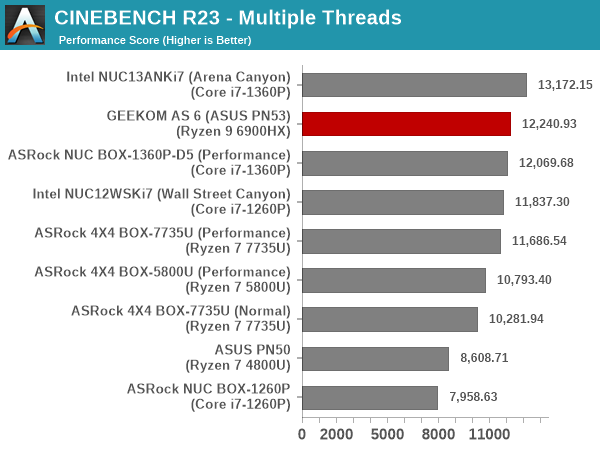
The Raptor Lake-P systems have a slightly higher processor power budget, but the single-threaded performance (even on a per-clock basis) is better in them compared to the Rembrandt systems. The GEEKOM AS 6 is in the middle of the pack, but comes out with a better performance in the multi-threaded cases. Only the Arena Canyon NUC outperforms the GEEKOM AS 6 in that workload.
Transcoding: Handbrake 1.5.1
Handbrake is one of the most user-friendly open source transcoding front-ends in the market. It allows users to opt for either software-based higher quality processing or hardware-based fast processing in their transcoding jobs. Our new test suite uses the 'Tears of Steel' 4K AVC video as input and transcodes it with a quality setting of 19 to create a 720p AVC stream and a 1080p HEVC stream.
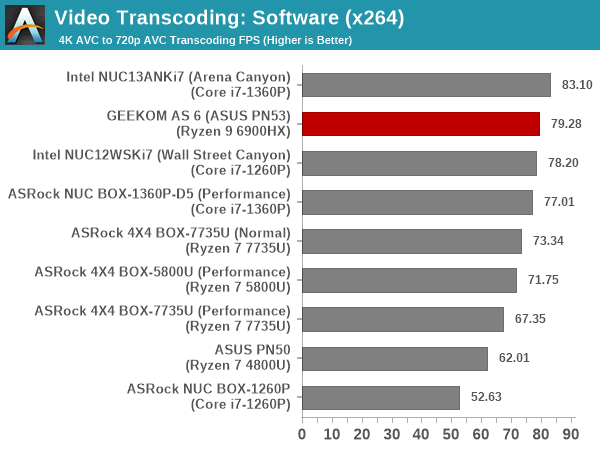
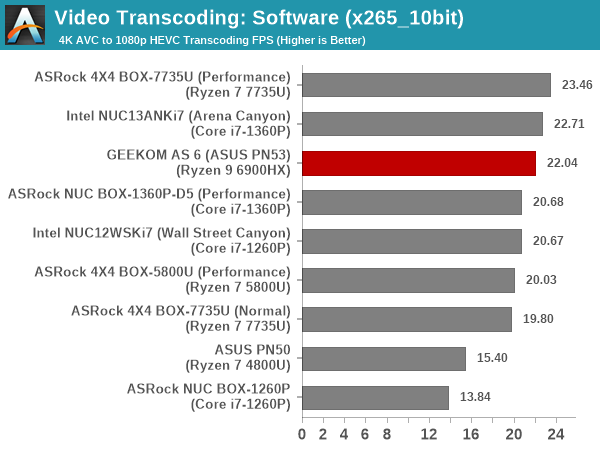
The presence of eight high-performance cores in the Rembrandt systems gives them a very good advantage for this multi-threaded benchmark. Higher power budget translates to higher performance given that they all have the same core counts. The Arena Canyon NUC enjoys a slight advantage over the GEEKOM AS 6, as the eight efficiency cores with a higher power budget seem to give it the edge over four high-performance cores in the latter.
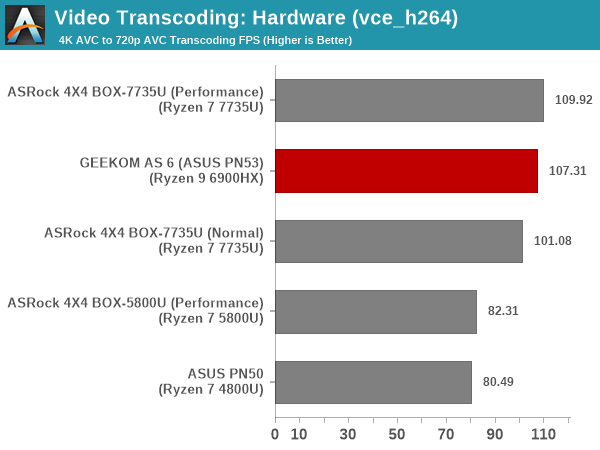

Hardware transcoding is available in the form of the VCE feature in the GPU. Intel systems have QuickSync, but a direct comparison is not advisable given that the encoding quality may differ. So, the comparison in the above graphs is restricted to AMD systems. The FPS is a function of the GPU clock rate and is directly tied to the available power budget. So, it is no surprise that the 4X4 BOX-7735U in Performance mode with a 42W TDP has a slight edge over the GEEKOM AS 6.
Archiving: 7-Zip 21.7
The 7-Zip benchmark is carried over from our previous test suite with an update to the latest version of the open source compression / decompression software.
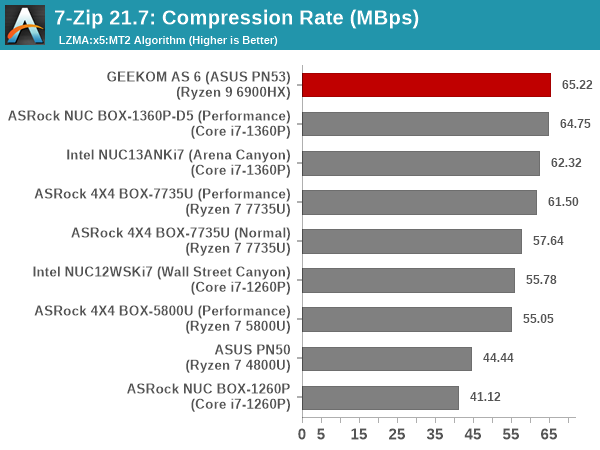
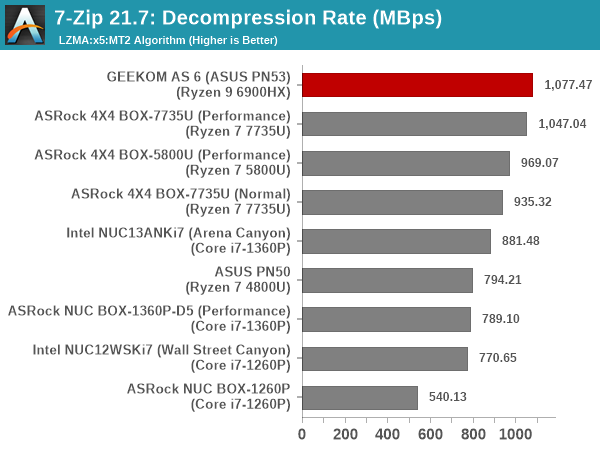
Raptor Lake-P and Rembrandt are neck-to-neck in terms of compression rates, with the GEEKOM AS 6 at the top (and the Arena Canyon NUC / ASRock Industrial NUC BOX-1360P/D5 following closely behind). However, decompression is a completely different story, with the Rembrandt systems enjoying as much as a 25% advantage in processing rates.
Web Browsing: JetStream, Speedometer, and Principled Technologies WebXPRT4
Web browser-based workloads have emerged as a major component of the typical home and business PC usage scenarios. For headless systems, many applications based on JavaScript are becoming relevant too. In order to evaluate systems for their JavaScript execution efficiency, we are carrying over the browser-focused benchmarks from the WebKit developers used in our notebook reviews. Hosted at BrowserBench, JetStream 2.0 benchmarks JavaScript and WebAssembly performance, while Speedometer measures web application responsiveness.
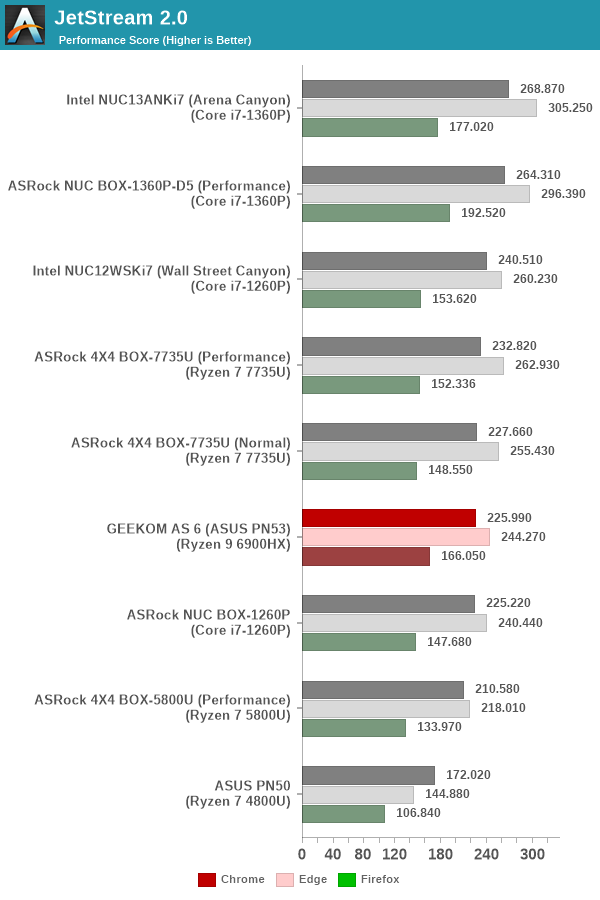
Raptor Lake-P's single-threaded advantage gives it the edge across all considered browsers in the JetStream 2.0 workload. The GEEKOM AS 6 slots in the middle of the pack. The same behavior is seen in the Speedometer 2.0 benchmark also.
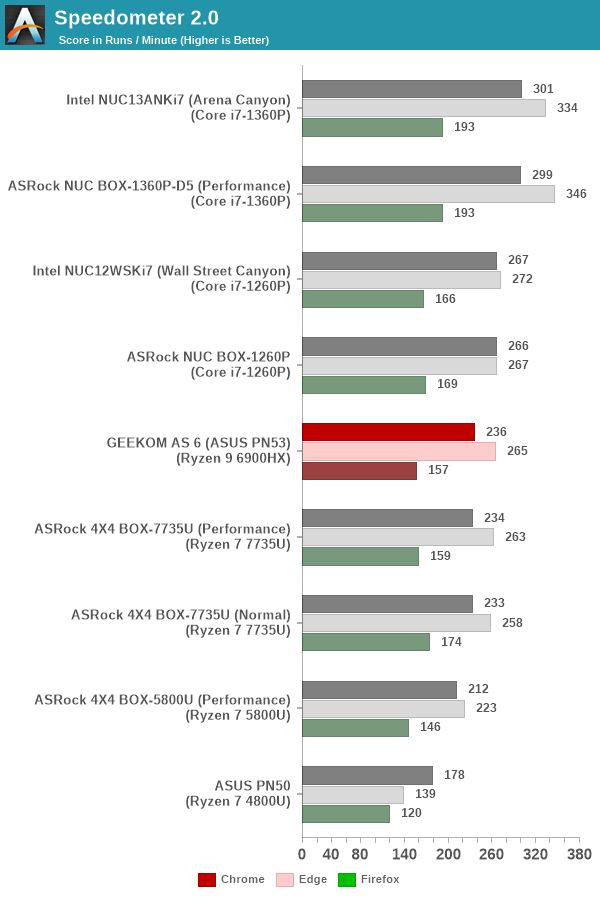
From a real-life workload perspective, we also process WebXPRT4 from Principled Technologies. WebXPRT4 benchmarks the performance of some popular JavaScript libraries that are widely used in websites.
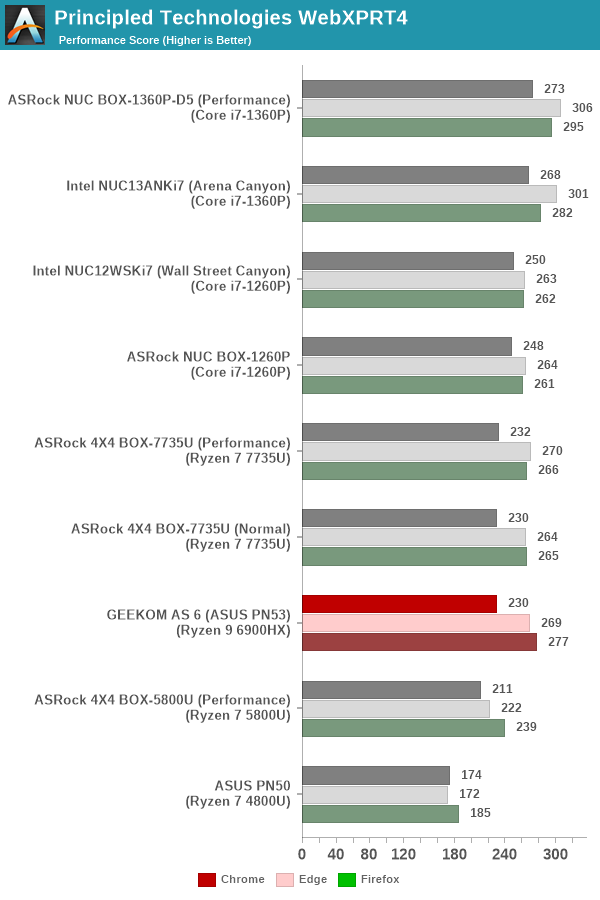
A mixed real-world browser workload in the form of WebXPRT4 also lines up the systems in an order similar to what was seen in Speedometer and JetStream. JavaScript performance seems to be primarily impacted by single-threaded performance.
Application Startup: GIMP 2.10.30
A new addition to our systems test suite is AppTimer - a benchmark that loads up a program and determines how long it takes for it to accept user inputs. We use GIMP 2.10.30 with a 50MB multi-layered xcf file as input. What we test here is the first run as well as the cached run - normally on the first time a user loads the GIMP package from a fresh install, the system has to configure a few dozen files that remain optimized on subsequent opening. For our test we delete those configured optimized files in order to force a fresh load every second time the software is run.

As it turns out, GIMP does optimizations for every CPU thread in the system, which requires that higher thread-count processors take a lot longer to run. So the test runs quick on systems with fewer threads, however fast cores are also needed. Raptor Lake-P edges out Rembrandt in this case across all considered systems, with the GEEKOM AS 6 not faring particularly well in the bottom half of the pack.
Cryptography Benchmarks
Cryptography has become an indispensable part of our interaction with computing systems. Almost all modern systems have some sort of hardware-acceleration for making cryptographic operations faster and more power efficient. In the case of IoT servers, many applications - including web server functionality and VPN - need cryptography acceleration.
BitLocker is a Windows features that encrypts entire disk volumes. While drives that offer encryption capabilities are dealt with using that feature, most legacy systems and external drives have to use the host system implementation. Windows has no direct benchmark for BitLocker. However, we cooked up a BitLocker operation sequence to determine the adeptness of the system at handling BitLocker operations. We start off with a 4.5GB RAM drive in which a 4GB VHD (virtual hard disk) is created. This VHD is then mounted, and BitLocker is enabled on the volume. Once the BitLocker encryption process gets done, BitLocker is disabled. This triggers a decryption process. The times taken to complete the encryption and decryption are recorded. This process is repeated 25 times, and the average of the last 20 iterations is graphed below.

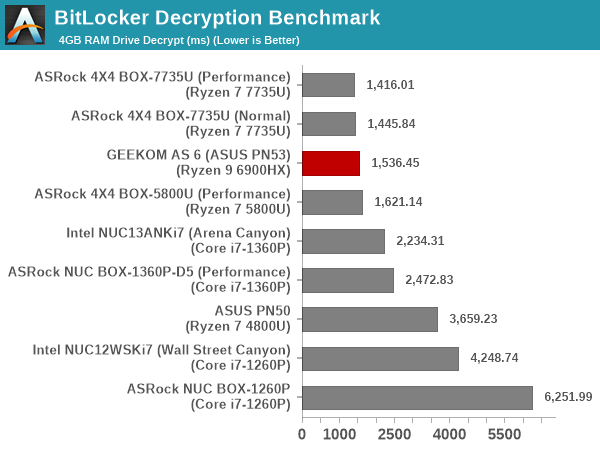
Hardware acceleration is available for the operations in all of the systems. The time taken for processing is directly dependent on the available power budget. The AMD systems have a significant advantage over the Intel ones in both encryption and decryption, possibly due to faster clocks across more cores.










14 Comments
View All Comments
haplo602 - Wednesday, August 2, 2023 - link
So you review an Asus rebrand but ignore all the upstart minipc manufacturers that were on the market months before this one ? Interesting choice ...nicolaim - Wednesday, August 2, 2023 - link
Me again. 2023, yet only two USB-C ports. WTF!?eriri-el - Monday, August 7, 2023 - link
"The activation of the GPU shaders for rendering in the GPU-HQ case results in relatively higher energy numbers for all the systems."Any citation for this? AFAIK GPU-HQ is just a profile to activate higher quality scaling.
Here is my citation:
https://github.com/mpv-player/mpv/blob/35a6b26b780...
If you tell me that the scalers are using shaders (which i'm not really sure whether are they doing so or not) then the non GPU-HQ preset scalers are shaders too and therefore GPU shaders are activated regardless you use GPU-HQ or not. Is your benchmark invalid since its based on a false premise?
ganeshts - Sunday, August 13, 2023 - link
There is no 'false premise' to talk of here - in fact, the attempt is to provide analysis based on the obtained results.The software used, and the settings are detailed in the section. Anybody can feel free to reproduce the results.
As for the statement 'activation of GPU shaders for GPU-HQ case' - the default case playback uses bilinear algorithm for chroma scaling (as an example), and that should be handled by fixed function hardware in most GPUs [ https://github.com/mpv-player/mpv/issues/10306#iss... ]. Of course, I have not looked in detail into the mpv code base, but based on the energy numbers for GPU-HQ vs. default (for the GEEKOM AS6 - 9.69 Wh vs. 8.12 Wh), and GPU D3D Usage for the two cases for different files, it looks like some additional work is being done on the GPU and my educated guess is that the GPU shader work is far more for GPU-HQ compared to the default case.